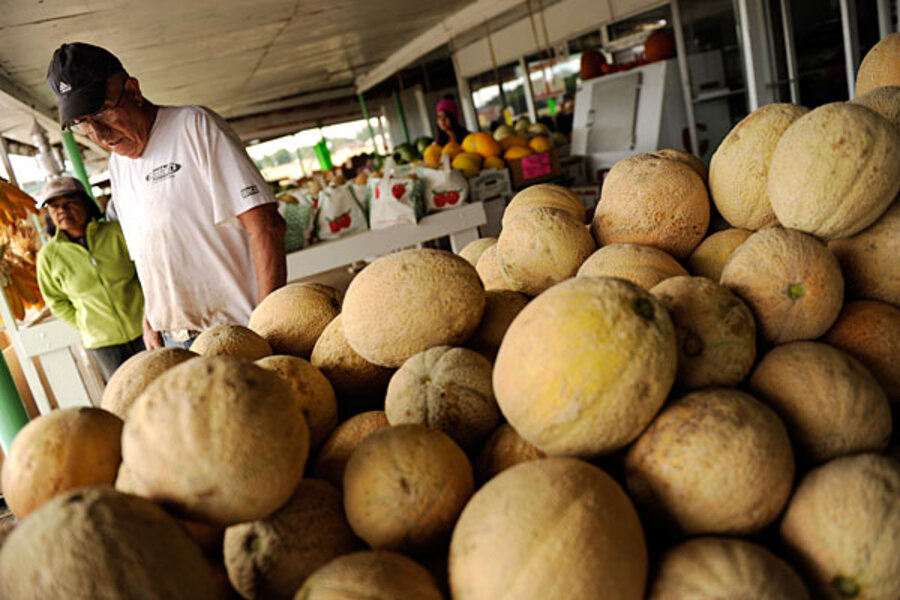Listeria outbreak: How safe is America's food chain?
Loading...
The deadliest food disease outbreak in more than a decade is highlighting how America’s farm-to-table food chain has changed – for the better and worse – in recent years.
Cantaloupes from an eastern Colorado farm, infected with a pathogen known as Listeria, have been linked to at least 16 fatalities in 18 states, according to the Centers for Disease Control and Prevention (CDC).
On one hand, it shows vulnerabilities in the food chain. Inspecting produce is a weak link, some analysts say. Other challenges unrelated to the current outbreak are becoming more severe, as well. For example, the food distribution system has gotten far more complicated with the advance of year-long distribution of meat, poultry, and produce from anywhere on the globe.
Yet recent days have provided evidence of improvements, too. Many food associations have instituted voluntary guidelines that show dramatic progress in cleanliness as well as trackability when something goes wrong. Indeed, all segments of the food chain, including consumers, have gotten more careful and vigilant in the last few years since E. coli outbreaks in spinach and lettuce made national headlines, analysts say.
“Progress has been made in the area of US food safety, but because the most-recent system was so very outdated, there are still very significant areas for improvement,” says Marcia Costello of the Villanova College of Nursing.
In the past, much of the focus has been on dairy and meat, says Patrick Rose, policy analyst at the University of Maryland Center for Health and Homeland Security. “So there is still a gap to fill in terms of our surveillance efforts for produce contaminants,” he says.
He and others say progress has been made in streamlining surveillance programs to better identify foodborne illness outbreaks, with various agencies working more closely together. One example includes the improved Coordinated Outbreak Response (CORE) Network, which is a collaboration between the Food and Drug Administration (FDA), the US Department of Agriculture, and CDC to improve monitoring of and responses to potential outbreaks.
The ability to track outbreaks has improved, though that can increase public fear. “Decades ago, these deaths would not have been connected,” says Christopher Ohl, an expert on infectious diseases at Wake Forest University Baptist Medical Center. “The people would have died unbeknownst to any common cause.”
More broadly, however, one of the greatest challenges to the food chain is its broader reach.
“Twenty years ago, you couldn’t get strawberries out of season, now they come in from South America and everywhere else," says Mr. Ohl. "This has exacerbated every problem of safety, regulation, and tracking at every point of the chain from the field to the dinner table.”
The Food Safety Modernization Act, which was signed into law in January, could help. It requires importers to verify the safety of food from their suppliers and gives the FDA authority to block foods from facilities or countries that refuse our inspection. The FDA will also be working more closely with foreign governments to increase its inspection of foreign food facilities.
“FDA’s new import tool kit will have a huge impact on food safety, given that an estimated 15 percent of the US food supply is imported, including 60 percent of fresh fruits and vegetables and 80 percent of seafood,” wrote Commissioner of Food and Drugs Margaret Hamburg, on the White House blog.
Critics say the FDA is underfunded in the area of inspections.
“The FDA is still lacking better tools to better monitor both locally and internationally imported produce and ensuring that citizens are safe," says Mr. Rose of Maryland. “Most importantly, public health outreach is not effective enough for various reasons. The simple remedy of paying better attention to hygiene is not entering our central conscience.”
One thing many farmers hope comes from this latest episode is that the FDA and CDC get better about informing the public about such outbreaks – and undercutting hysteria.
“The FDA and CDC really got their minds around this one quickly and have therefore saved many lives and needless infections,” says Steve Patricio, who was chairman of the Western Growers Association in 2007 when E. coli was found in spinach.
Within record time, they identified the single source and single shipper of contaminated cantaloupes and had the product pulled from stores, he says. “I think a big lesson here is that consumers should get their information directly from the CDC and FDA websites rather than from the media, which tend to needlessly escalate the fear.”
[ Video is no longer available. ]





